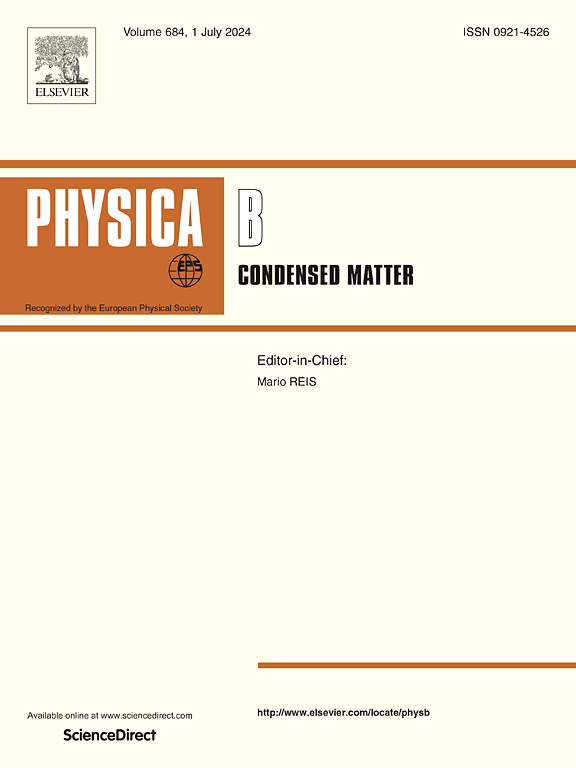Impact of ZnO on structural, acoustic, and radiation shielding characteristics of B2O3-SrO-Sm2O3 glasses
IF 2.8
3区 物理与天体物理
Q2 PHYSICS, CONDENSED MATTER
引用次数: 0
Abstract
B2O3-SrO-Sm2O3 glass systems were fabricated using the rapid-quenching method, incorporating varying concentrations of ZnO. The FTIR and Raman spectroscopies were employed to characterize the glasses. Physical properties including density and molar volume were determined, and ultrasonic wave velocities were measured, allowing for the calculation of elastic moduli. The observed trends in these properties were attributed to the impact of ZnO. An increase in the glass rigidity, manifested by a higher density, was correlated with an elevated cross-link density and an increased number of bonds within the glass network. An increase in the molar volume indicated an expansion of the glass network upon the addition of ZnO. The results suggest that Zn2+ ions preferentially incorporate into the glass network as ZnO4 units, acting as network formers. The shielding effectiveness of the glasses was evaluated by analyzing their Zeff, MFP, and HVL. The results demonstrated superior gamma-ray shielding properties in these glasses, attributed to their higher Zeff and lower MFP and HVL values. These findings suggested that the prepared glasses had the potential to serve as alternatives to traditional materials used for γ-ray attenuation.
ZnO对B2O3-SrO-Sm2O3玻璃结构、声学和辐射屏蔽特性的影响
采用快速淬火法制造了 B2O3-SrO-Sm2O3 玻璃系统,其中加入了不同浓度的氧化锌。利用傅立叶变换红外光谱和拉曼光谱对玻璃进行了表征。测定了包括密度和摩尔体积在内的物理特性,并测量了超声波速度,从而计算出弹性模量。观察到的这些特性的变化趋势归因于氧化锌的影响。玻璃刚度的增加(表现为更高的密度)与玻璃网络中交联密度的增加和键数的增加有关。摩尔体积的增加表明加入氧化锌后玻璃网络发生了扩张。结果表明,Zn2+ 离子作为 ZnO4 单元优先融入玻璃网络,起到了网络形成器的作用。通过分析玻璃的 Zeff、MFP 和 HVL,对玻璃的屏蔽效果进行了评估。结果表明,这些玻璃具有较高的 Zeff 值、较低的 MFP 值和 HVL 值,因而具有优异的伽马射线屏蔽性能。这些研究结果表明,制备的玻璃具有替代传统γ射线衰减材料的潜力。
本文章由计算机程序翻译,如有差异,请以英文原文为准。
求助全文
约1分钟内获得全文
求助全文
来源期刊

Physica B-condensed Matter
物理-物理:凝聚态物理
CiteScore
4.90
自引率
7.10%
发文量
703
审稿时长
44 days
期刊介绍:
Physica B: Condensed Matter comprises all condensed matter and material physics that involve theoretical, computational and experimental work.
Papers should contain further developments and a proper discussion on the physics of experimental or theoretical results in one of the following areas:
-Magnetism
-Materials physics
-Nanostructures and nanomaterials
-Optics and optical materials
-Quantum materials
-Semiconductors
-Strongly correlated systems
-Superconductivity
-Surfaces and interfaces
 求助内容:
求助内容: 应助结果提醒方式:
应助结果提醒方式:


